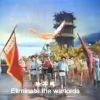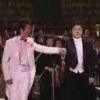Traditional Acrobatics in the Model Works
As didactic as traditionally remains the use in the revolutionary operas of the spectacular acrobatics (da 打) from Beijing Opera, certainly one of the reasons why the art form has always been so popular. The model works would have been foolish to eliminate this element. There are unforgettable moments in some of these operas (and the ballets are sure to include acrobatics, too). The decapping of landmines, for example, is done in a dance-like fashion in Raid on White Tiger Regiment. Similarly spectacular are the cargo- and sack-carrying dances in On the Docks. Breathtaking, too, is the scene showing the militia on skis moving up Tiger Mountain in Taking Tiger Mountain by Strategy as seen in this illustration (ill. 1.8a).
Arguably one of the most beautiful scenes in the model works is to be found in Song of the Dragon River (scene 5) where heroine Jiang Shuiying and other members of the brigade create a human barricade against the roaring waters while others repair the broken portion of the dam. In this scene, too, the acrobatic abilities of the performers are spectacularly showcased: the actors perform long and incredibly fast successions of flip-flops and somersaults, they build bridges for each other and jump over them, and so on (see Scene 5).
The preceding fight over firewood, too, (scene 4) reminds the audience of elements well known from man-to-man assaults in Beijing Opera: sudden clashes, somersaults, and more or less exciting or awkward falls. In these fights, the good and the bad are demarcated in the acrobatic movements in traditional opera, and the revolutionary operas make no exception to this rule (see the illustration)—indeed, all of them use such fighting scenes to add to their particular dramatic effect, and this dramatic effect is translated into model ballets, too. In the White-Haired Girl, hero Dachun is depicted in a much superior manner over the landlord and his bullies (ill. 1.8b).























